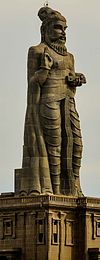George Uglow Pope
George Uglow Pope | |
|---|---|
Bedeque, Prince Edward Island, Canada | |
| Died | 11 February 1908 (aged 87) |
| Resting place | St Sepulchre's Cemetery, Jericho, Oxford, England |
| Occupations |
|
| Spouses | Mary Carver (m. 1841–1845)Henrietta Page (m. 1849) |
George Uglow Pope (24 April 1820 – 11 February 1908), or G. U. Pope, was an
He later took to teaching, running his own school in
Biography

George Uglow Pope was born on 24 April 1820 in
He left for
Returning to Tanjore (now Thanjavur) in 1851, teaching at St Peter's School, he found himself in conflict with other missionaries. In 1855, a Tamil priest Vedanayakam Shastri who was a disciple of Schwartz and a poet in the court of Maharaja Serfoji was flogged publicly resulting in a separation of Tamil church free of the Anglican church leading to the resignation of Pope. He founded a seminary at Sawyerpuram for training Anglican Tamil clergy but this too ran into trouble and he decided to move to Ootacamund (Ooty) in 1859. Here he founded a grammar school for European children (which ran from 1859 to 1870) which is now home to the Government Arts School and Stonehouse. The grammar school at Stonehouse cottage was opened by the Bishop of Madras on 2 July 1858 with Pope as Principal. The school moved elsewhere as the building was sold to the Trustees of the Lawrence Asylum in March 1859. Stonehouse cottage was then used to house the male asylum inmates and the Grammar school moved to new premises in Lovedale on 1 April 1869.[3] He also founded Holy Trinity Church in Ooty.[2] Pope was referred to with respect by the Tamilians as Pope Aiyar.[4]
Pope became famous for his strictness and in 1870 he was made principal of Bishop Cotton Boys' School at
He died on 11 February 1908. He delivered his last sermon on 26 May 1907. Pope was buried at St Sepulchre's Cemetery, located in Jericho, central Oxford, England. After his death, his second wife, Henrietta, and two daughters received pension. Henrietta died on 11 September 1911 and is buried beside Pope. Three of their sons continued to work in India. John Van Someren Pope worked on education in Burma, Arthur William Uglow Pope served as a railway engineer in India and China; while Lieutenant-Colonel Thomas Henry served in the medical service as a professor of ophthalmology at the Madras Medical College.[2]
Contributions to Tamil studies
Pope was along with Joseph Constantius Beschi,
- First lessons in Tamil: or a full introduction to the common dialect of that language, on the plan of Ollendorf and Arnold, Madras, 1856 (1st edition) - the next edition was published as:
- A Tamil hand-book: or full introduction to the common dialect of that language on the plan of Ollendorf and Arnold, Madras, 1859 (2nd edition), 1867 (3rd edition)
- A handbook of the ordinary dialect of the Tamil language, London, 1883 (4th edition, 3 volumes - Part 4-dictionary), Oxford 1904 (7th edition)
- A larger grammar of the Tamil language in both its dialects], Madras, 1858
- Pope's second catechism of Tamil grammar, 1858
- A text-book of Indian history; with geographical notes, genealogical tables, examination questions, and chronological, biographical, geographical, and general indexes, London, 1871 (1st edition), 1880 (3rd edition)
- திருவள்ளுவர் அருளிச்செய்த திருக்குறள் (Tiruvalluvar arulicceyta Tirrukkural). The 'Sacred' Kurral of Tiruvalluva-Nayanar, London, 1886
- முனிவர் அருளிச்செய்த நாலடியார் (The Naladiyar, or, Four hundred quatrains in Tamil), Oxford, 1893
- St. John in the Desert: an introduction and notes to Browning's 'a death in the desert', Oxford, 1897
- The Tiruvacagam; or, 'Sacred utterances' of the Tamil poet, saint, and sage Manikka-Vacagar: the Tamil text of the fifty-one poems, with English translation, Oxford, 1900
- A catalogue of the Tamil books in the library of the British Museum, London, 1909 (with L. D. Barnett)
Criticism
Pope has occasionally been criticised for over-emphasising certain texts from ancient Tamil literature while downplaying, or even dismissing, others, both ancient and more recent.
See also
- Tirukkural
- Tirukkural translations
- Tirukkural translations into English
- List of translators into English
- Thiruvasagam
- Tamil Nadu / South India
References
- ^ "Uglow Family History". www.kent.ac.uk. Retrieved 31 December 2015.
- ^ doi:10.1093/ref:odnb/35572. Retrieved 20 October 2016. (Subscription or UK public library membershiprequired.)
- ^ Price, Frederick (1908). Ootacamund. A History. Madras: Government Press. p. 20.
- ^ Thurston, Edgar (1909). Castes and tribes of southern India. Volume I-A and B. Government Press. p. 19.
- ^ Rizvi, Aliyeh (29 December 2014). "Resident Rendezvoyeur: A natural state of grace". Bangalore Mirror. Retrieved 29 December 2014.
- ISBN 978-0-520-93190-9
- ISBN 9788191067378.
External links
- St Peter's School Thanjavur
- Page on Pope's grave in St Sepulchre's Cemetery, Oxford, with biography
- The Lutheran Aggression: A Letter to the Tranquebar Missionaries, by G.U. Pope (1853)
- Resident Rendezvoyeur: A natural state of grace by Aliyeh Rizvi
- Works by or about George Uglow Pope at Internet Archive
- Works by George Uglow Pope at LibriVox (public domain audiobooks)


